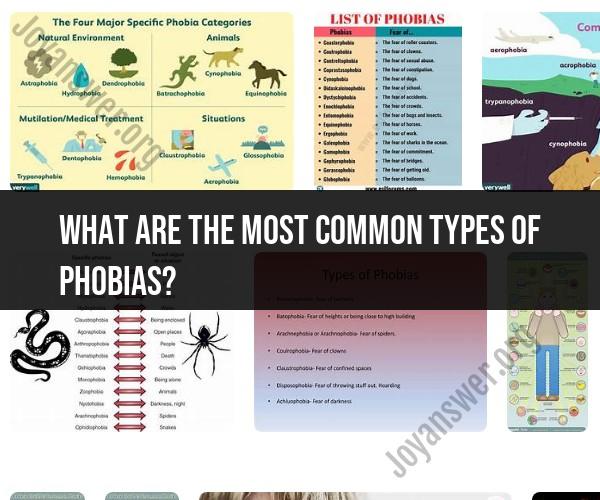What are the most common types of phobias?
Phobias are irrational and intense fears of specific objects, situations, or experiences. They are one of the most common types of anxiety disorders. Some of the most common types of phobias include:
Specific Phobias: These are phobias related to specific objects or situations. Some common specific phobias include:
- Arachnophobia: Fear of spiders.
- Ophidiophobia: Fear of snakes.
- Acrophobia: Fear of heights.
- Claustrophobia: Fear of confined spaces.
- Aerophobia: Fear of flying.
- Dentophobia: Fear of dentists.
- Trypophobia: Fear of clustered holes or bumps.
- Hemophobia: Fear of blood.
- Astraphobia: Fear of thunder and lightning.
Social Anxiety Disorder (Social Phobia): This involves an extreme fear of social situations and being negatively evaluated by others. It can include a fear of public speaking, meeting new people, or attending social events.
Agoraphobia: Agoraphobia is the fear of being in situations where escape might be difficult or embarrassing. It often leads to avoidance of crowded places, open spaces, or situations where help may not be readily available.
Generalized Anxiety Disorder (GAD): While not typically considered a phobia, GAD involves excessive and persistent worry and anxiety about various aspects of life, such as work, relationships, and health.
Panic Disorder: Panic disorder is characterized by recurring panic attacks, which are sudden episodes of intense fear and physical symptoms like a racing heart, shortness of breath, and chest pain. These attacks often occur without warning.
Emetophobia: Emetophobia is the fear of vomiting or seeing others vomit. It can lead to avoidance of situations involving illness or nausea.
Animal Phobias: These are specific phobias related to animals, such as dogs, cats, snakes, or insects.
Blood-Injection-Injury Phobia: This phobia involves a fear of blood, needles, or medical procedures. Some individuals with this phobia may experience fainting in response to the phobic stimulus.
Driving Phobia (Vehophobia): Vehophobia is the fear of driving or being a passenger in a vehicle. It can significantly limit an individual's ability to travel.
Thanatophobia: Thanatophobia is the fear of death or the fear of dying.
It's important to note that phobias can vary in intensity, and the impact on a person's life can range from mild discomfort to severe impairment. Fortunately, various effective treatments are available for phobias, including cognitive-behavioral therapy (CBT), exposure therapy, and medication when necessary. If you or someone you know is struggling with a phobia that interferes with daily life, seeking help from a mental health professional is recommended.
Common Phobias Unveiled: Exploring the Most Prevalent Fears
Phobias are a type of anxiety disorder characterized by an intense or irrational fear of a specific object or situation. Phobias can be so severe that they interfere with a person's daily life. There are many different types of phobias, but some are more common than others.
Here is a list of some of the most common phobias:
- Arachnophobia: Fear of spiders
- Ophidiophobia: Fear of snakes
- Acrophobia: Fear of heights
- Aerophobia: Fear of flying
- Claustrophobia: Fear of enclosed spaces
- Agoraphobia: Fear of open spaces or crowded places
- Social phobia: Fear of social situations
- Trypanophobia: Fear of needles
- Mysophobia: Fear of germs
- Emetophobia: Fear of vomiting
- Nyctophobia: Fear of the dark
- Zoophobia: Fear of animals
Common phobias are thought to be caused by a combination of genetic and environmental factors. For example, a person who has a family history of phobias is more likely to develop a phobia themselves. Additionally, traumatic experiences, such as being bitten by a spider, can lead to the development of a phobia.
The Fear Factor: Understanding and Coping with Common Phobias
People with phobias may experience a variety of symptoms, including anxiety, panic attacks, and avoidance. The severity of symptoms can vary from person to person. Some people may be able to manage their phobia without treatment, while others may need professional help.
There are a number of different treatments available for common phobias, including therapy and medication. Therapy can help people to understand their phobia and develop coping mechanisms. Medication can help to reduce anxiety and panic attacks.
Overcoming Phobias: Strategies for Conquering Your Deepest Fears
If you have a common phobia, there are a number of things you can do to overcome it:
- Learn about your phobia. The more you know about your phobia, the better equipped you will be to manage it.
- Develop coping mechanisms. There are a number of different coping mechanisms that can help you to manage your fear. For example, you may find it helpful to practice relaxation techniques or to challenge your negative thoughts.
- Seek professional help. If you are struggling to manage your phobia on your own, seek professional help from a therapist or counselor.
Overcoming a phobia takes time and effort, but it is possible. If you are committed to recovery, there is no reason why you cannot overcome your fear and live a full and productive life.
Here are some additional tips for overcoming a common phobia:
- Set realistic goals. Don't try to do too much too soon. Start by setting small, achievable goals, such as being able to look at a picture of your phobia without panicking.
- Expose yourself to your fear gradually. Once you are comfortable with your small goals, you can start to expose yourself to your fear in a safe and controlled environment. For example, if you are afraid of spiders, you could start by looking at pictures of spiders and then gradually work your way up to seeing live spiders.
- Reward yourself for your progress. It is important to reward yourself for your progress, no matter how small it may seem. This will help you to stay motivated and on track.
Remember, you are not alone. Millions of people around the world have phobias. There is help available, and you can overcome your fear.













